Museum of Vacuum
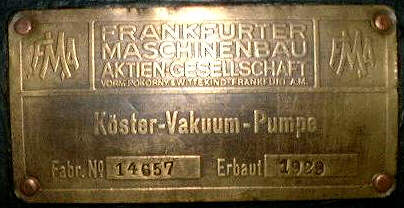
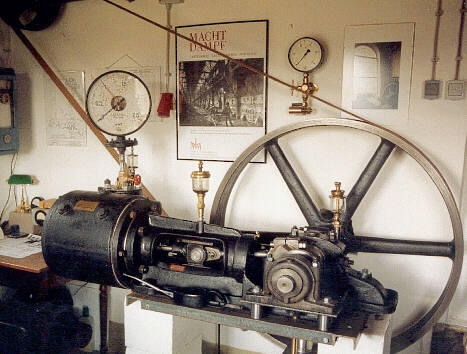 Das kleine Maschinenmuseum in Bad Driburg
Das kleine Maschinenmuseum in Bad Driburg
Die Vakuumpumpe (Zylinderdurchmesser 308mm) wurde 1929 von der Frankfurter Maschinenbau Aktiengesellschaft (vorm. Pokorny & Wittekind) gebaut und arbeitete bis Mitte der 80er Jahre bei der Firma Degussa in Brilon Wald.
www.maschinenmuseum.de
|
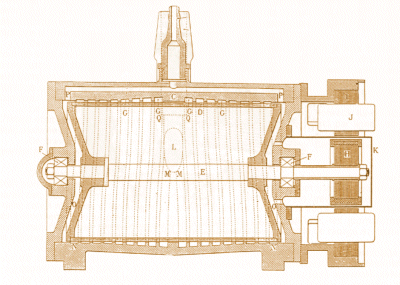 Pompe à vide moléculaire (modèle Holweck N°2 de mai 1922)
Pompe à vide moléculaire (modèle Holweck N°2 de mai 1922)
|
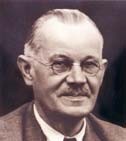
1908, Wilhelm Wiegand obtains the patent for a multi-effect circulation evaporator
1908, Wilhelm Wiegand erhält Patent auf einen mehrstufigen Umlaufverdampfer
Die Produktion von Apparaten am Standort Merseburg geht zurück in das Jahr 1908, als Wilhelm Wiegand den ersten Verdampfer zur Eindampfung von Gerbbrühen entwickelte.
1920 wurde die "Apparatebau GmbH Wilhelm Wiegand" gegründet,
1930 wurdedie Abteilung Strahlpumpen und Strahlapparate eingerichtet.
|
In 1871 Ernst and Berthold Körting founded a company and called it "Gebrüder Körting" (Körting Bros.).
Then in the same year Ernst Körting, applying the law of fluid dynamics, designed and constructed the "Injector" as a steam jet boiler feed pump. On the basis of this design, all constructional forms of ejectors known today were developed and which now form a firm component part of many processing plants.
Ernst und Berthold Körting gründeten 1871 die Firma "Gebrüder Körting".
Im gleichen Jahr konstruierte und entwickelte Ernst Körting unter konsequenter Anwendung der Strömungslehre den "Injektor" als Dampfstrahl-Kesselspeisepumpe. Darauf aufbauend wurden innerhalb weniger Jahre alle bekannten Bauarten von Strahlpumpen entwickelt, die heute zu einem festen Bestandteil vieler verfahrenstechnischer Anlagen geworden sind.
|
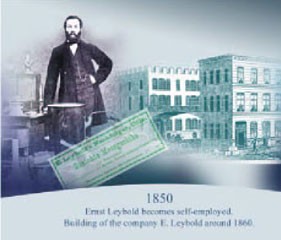
Ernst Leybold (1827-1907)
Today's worldwide market leader in vacuum technology began its impressive development 150 years ago as the modest commission and forwarding business of Ernst Leybold(1827-1907), who was dealing in foreign wines and assorted apothecary wares such as medicine glasses, ointment jars, thermometers and scales. In 1854 he expanded his line of merchandise to include physical, pharmaceutical and chemical apparatuses. In response to a growing need and demand, in 1867 he set up a glass-blowing operation and a mechanical workshop. That was the beginning of his manufacture of physical devices for use in teaching science and in the laboratory.
In 1870 Ernst Leybold retired and sold the company to Emil Schmidt and Otto Ladendorff, who renamed it "E. Leybold's Nachfolger".
|
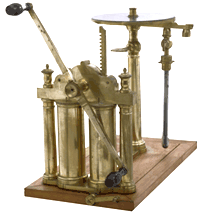 Restauration à l'atelier de l'Ecole polytechnique d'une pompe à vide Fortin
Restauration à l'atelier de l'Ecole polytechnique d'une pompe à vide Fortin
La pompe à vide présentée a été restaurée et exposée par Yves Baurel en 1997 à l'Ecole Polytechnique.
Elle possède deux corps de pompe en laiton, les pistons sont munis de crémaillères commandées par une roue dentée, à laquelle on imprime un mouvement alternatif au moyen d'un levier. L'association de deux corps de pompe pour diminuer l'effort à faire pour vaincre la pression atmosphérique est une idée conjointe à Papin, ís Gravesande et Hauksbée. La pression qui reste dans ce récipient est donnée par l'éprouvette située à côté de celui-ci. Il s'agit d'un tube qui renferme un baromètre à siphon à deux branches égales, dit baromètre tronqué. Il indique les pressions faibles par les différences de niveau entre les deux branches. La pression qui reste dans le récipient peut également se mesurer à l'aide d'un tube vertical, relié à la deuxième ouverture latérale, et dont l'extrémité inférieure plonge dans un vase plein de mercure. Ce tube s'apparente au dispositif du baromètre de Fortin : quand la pression diminue dans le récipient, le mercure monte dans le tube. Le robinet à l'avant du plateau sert à faire entrer l'air dans le récipient, ce qui serait impossible sans lui à cause de la pression atmosphérique.
|
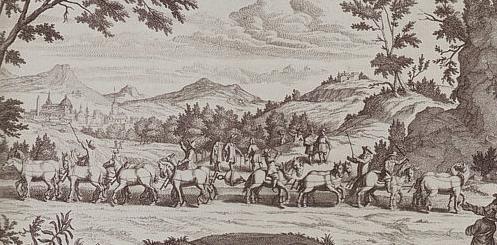 Deutsches Museum Bonn
Deutsches Museum Bonn
Die Magdeburger Halbkugeln von Otto von Guericke
Zweimal acht Pferden gelang es nicht, zwei evakuierte Kupferhalbkugeln von etwa 50cm Durchmesser, die durch einen Lederstreifen gedichtet waren, zu trennen.
- Der Luftdruck wirkt auf beide Seiten der Zugkraft der Pferde entgegen.
Otto von Guericke (1602-1686) inszeniert in Magdeburg ein aufsehenerregendes Experiment mit zwei Kupferschalen: Mit einer »umgekehrten« Feuerspritze pumpt Guericke die Luft aus den lose aneinanderliegenden Halbkugeln.
Dann spannt er an jede Kupferschale acht Pferde und treibt sie an. Den Pferden aber gelingt es nicht, diese voneinander zu trennen. Der Luftdruck, ist stärker.
Bild: Otto von Guerickes Magdeburger-Halbkugel-Versuch als Stich aus seinem 1672 in Amsterdam erschienenen Buch.
https://www.deutsches-museum-bonn.de/
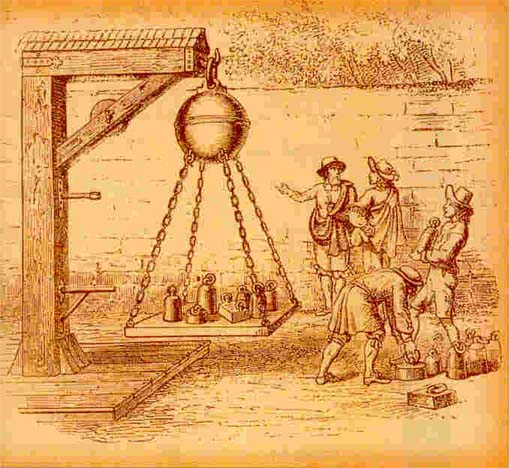
|
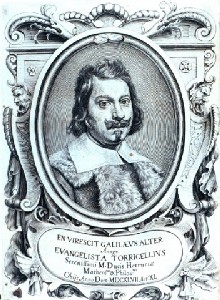 Il primo barometro - L'esperimento di Torricelli e Viviani
Il primo barometro - L'esperimento di Torricelli e Viviani
Torricelli was the first person to create a sustained vacuum and to discover the principle of a barometer.
In 1643 he proposed an experiment, later performed by his colleague Vincenzo Viviani, that demonstrated that atmospheric pressure determines the height to which a fluid will rise in a tube inverted over the same liquid. This concept led to the development of the barometer. Torricelli wrote a letter to his friend Michelangelo Ricci, who like him had been a student of Castelli, on 11 June 1644. At this stage Torricelli was in Florence, writing to his friend Ricci who was in Rome.
I have already called attention to certain philosophical experiments that are in progress ... relating to vacuum, designed not just to make a vacuum but to make an instrument which will exhibit changes in the atmosphere, which is sometimes heavier and denser and at other times lighter and thinner. Many have argued that a vacuum does not exist, others claim it exists only with difficulty in spite of the repugnance of nature; I know of no one who claims it easily exists without any resistance from nature.
Some of Torricelli's manuscripts were lost and it was not until 1919 that the remaining material was published as Torricelli had wished. His collected works were published with Gino Loria and Guiseppe Vassura as editors, three volumes being published in 1919 and the fourth volume in 1944 nearly 300 years after Torricelli's death. Sadly material left by him, bearing his own signature, was destroyed in the Torricelli Museum in Faenza in 1944.
external links:
Evangelista Torricelli,
a biography edited by Egidio Festa, Institute and Museum of History of Science, Florence, Italy
Torricelli and Viviani demonstrate that air has a weight.
Evangelista Torricelli
|
|
vacuum-guide.com
Gallery of paintings
Stamps collection
|